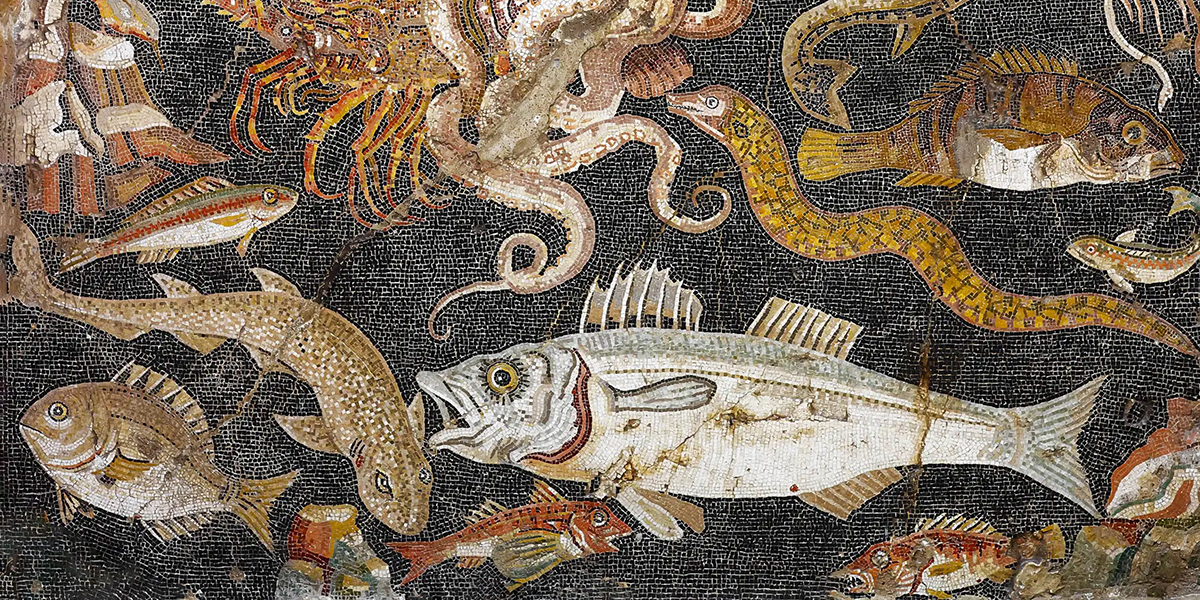Fishing, just like today where it is an important economic resource for many communities around the world, has played a significant role in human life and livelihood since the beginning. Fish, besides being a food source for settlements established near the sea, rivers, and lagoons, has also contributed to their economic development. However, archaeological excavations in prehistoric or classical Greek cities have revealed a limited number of findings related to seafood. The small and fragile nature of fish bones, along with the difficulty of their identification, has played a significant role in this scarcity. Apart from the abundant shells of marine mollusks, fish bones that have survived to the present day are generally found to belong to larger species.
In addition, advanced technology was used for the fishing of tuna, which maintained its economic value during the Ancient Greek and Roman Imperial periods, especially becoming an important industrial material for cities located on the seasonal migration routes along the Black Sea and Eastern Mediterranean coasts. It is known that groups of fishermen who gathered to catch large amounts of tuna during the migration season used extensive equipment they had prepared in advance.
Sturgeons, belonging to the Acipenseridae family, are marine but occasionally migrate individually or in groups to freshwaters for spawning. Sturgeon, especially in the Black Sea region, was a significant commercial commodity in the ancient period. Species belonging to this family, such as Beluga Sturgeon (Huso huso), Stellate Sturgeon (Acipenser stellatus), Russian Sturgeon (Acipenser gueldenstaedti), and Sturgeon (Acipenser sinensis), were present in various rivers and seas around Anatolia during the Roman Imperial period.
Herodotus mentions the abundance of large fish, called “antakaios” or “akkipesios,” caught in the Dnieper River for extracting caviar. Strabo emphasizes the use of a tool called “gangame” to catch sturgeon under the ice in the Black Sea. Sturgeon, especially the sturgeon caught off the coast of Pamphylia during the Roman Imperial period, attracted great interest and was known as “ellops.” Large-sized fish bones, frequently found in archaeological remains, include carp (ballagros, kyprinos) and catfish (glaneos, silouros), indicating the scale of freshwater fishing. Carp from the Cyprinidae family, particularly Cyprinus carpio, was one of the most hunted fish during the Prehistoric and Classical periods.
In addition to freshwater fishing meeting daily nutritional needs and contributing to household economies, various types of freshwater fish such as chub, catfish, whitefish, and eel were inevitably caught. Migratory fish like bonito and mackerel, belonging to the Scombridae family, were also commercially valuable in the ancient world. In ancient times, especially during the Roman Imperial period, salted fish made from bonito (pilamus) and mackerel (scomberos) were crucial for the Black Sea, and the Dardanelles and Bosporus were famous for these fish.
Sardines (Sardina pilchardus), a coastal fish from the Clupeidae family, were extensively used in the Roman Imperial period for making fish sauce and salted fish. The affordability of salted or dried sardines made them a common choice for consumption by ordinary people. Sardines were also used in the preparation of fish sauce in Roman cuisine, contributing to their high economic value in the Mediterranean world.
Remains of serranid fishes, especially grouper (Epinephelus guaza) and dusky grouper (Epinephelus aeneus), indicate that species belonging to the Serranidae family were widely hunted during ancient times. Evidence from Cyprus suggests that certain species of serranids, economically significant as both a commodity and a food source, were extensively caught as early as the 8th millennium BCE.
It is important to note that the names of these fish in ancient sources may not always correspond directly to modern fish species. Initially, people did not have the luxury of choosing which fish to catch for their food and livelihood. However, as culinary culture evolved and tastes developed, certain fish species gained priority. Large fish ponds filled with seawater were also built by the wealthy during the Roman Imperial period to breed fish. Fish bred in these ponds became so significant that they were named after individuals. For example, Sergius Aurata derived his name from the sea bream he raised and sold, and Lucinius Muraena took his name from the moray eel. Many other fish names are mentioned in ancient sources, but determining which modern fish they correspond to can be challenging.
In conclusion, fish, being among the primary food sources of coastal settlements, played a crucial role in the daily life and economy of ancient Anatolian communities.

